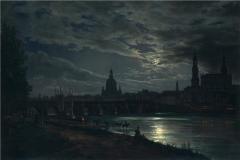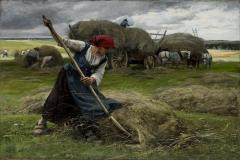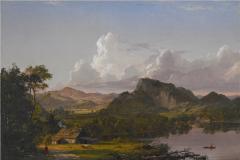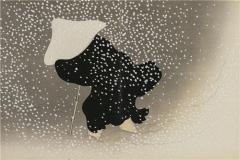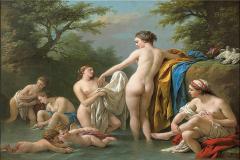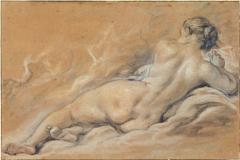山水画示范在油——”肖湾”
阶段1
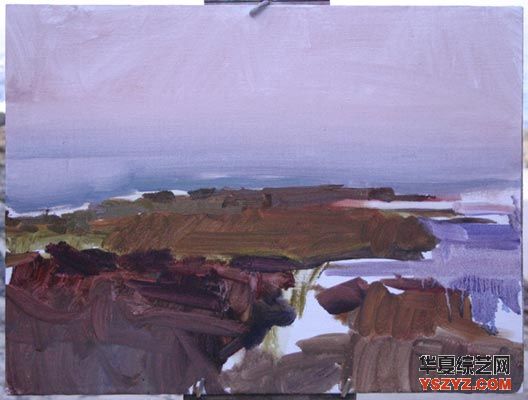
这幅画是在7月完成六年的拉古那空气在拉古纳海滩练习活动,CA。我使用数码相机拍摄外景的捕获绘画在其各个阶段。我有各种各样的开始我的绘画。根据其复杂的场景我可能开始于一个更加精炼的素描或在这种情况下我开始与一个松散的油漆/溶剂油洗去定义群众。这开始阶段设置速度为场景的角度,光线和阴影质量,积极和消极的区域的场景。艺术家也需要发展很快的焦点,或至少知道这将发生在作文。
阶段2
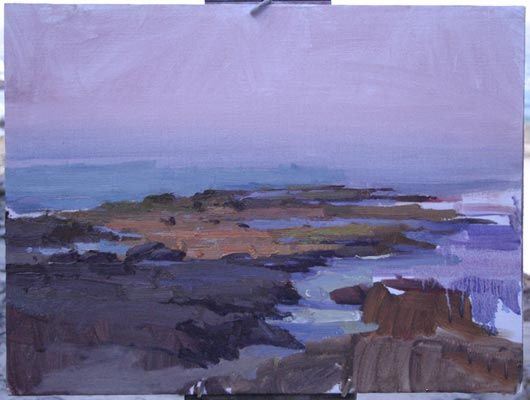
第二个阶段是非常重要的,我必须开发区域在阴影与领域还轻。这个区域将被二次焦点区域的绘画。我已经知道主要的焦点将是,我只是没有时间在这一点上用。这个练习必须关心空气画家他或她自己不断移动的光。什么是在影子现在可能在10分钟或更少成为充满光所以艺术家需要发展绘画牢记这一点。在这里,我开始在一个更透明的方式画在初始洗区域的光线和阴影,建立正确的价值和色温。水周围的岩石,也得到重视。
阶段3
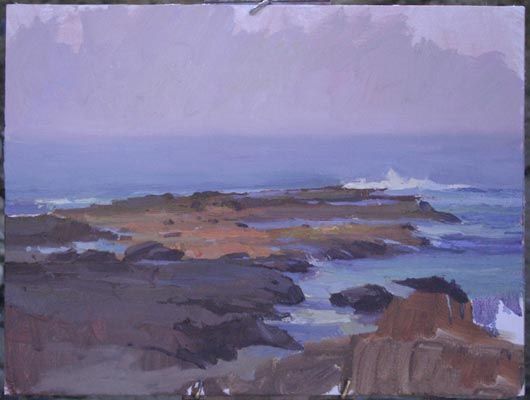
从一开始的一件事引起了我的兴趣在这个场景是偶尔的波行动反对遥远的岩石。这将是我的主要焦点,因此在这个阶段我观察一段时间以确定在波浪的什么阶段波撞击岩石,我想描绘。这是放置在随着海洋开发的基础与地平线和放置在一些天空值和颜色。
阶段4
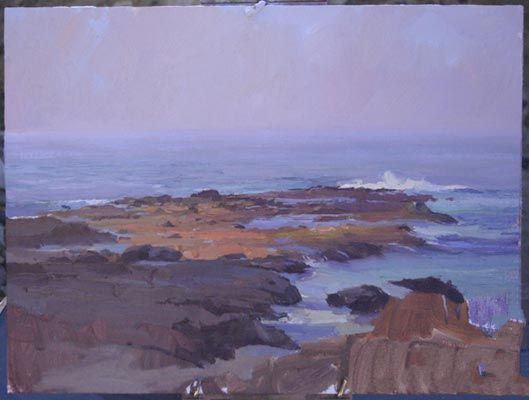
这是一个细化阶段;我的眼睛不断地扫描现场看见,和谐在现场,可以肯定的是保留在绘画和谐。天空是没有价值的进一步发展与变化而微妙的颜色温度的变化。更微妙的注意微妙的海洋颜色与建议的波的运动。我也让低调增加岩石地区。观察我的潮流图我注意,退潮了所以我将知道更多的岩石,将开始暴露,这可能有助于完成作文。
阶段5
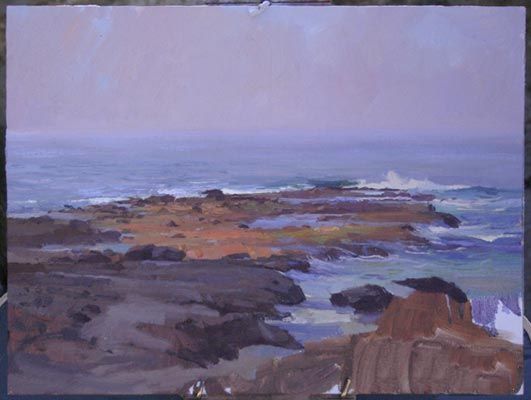
这个阶段我继续发展的精妙之处海洋用额外的光与暗值放置在某些方面给建议的海浪和海浪的岩石上。我开始开发前景区域阴影下的左手角落。
阶段6
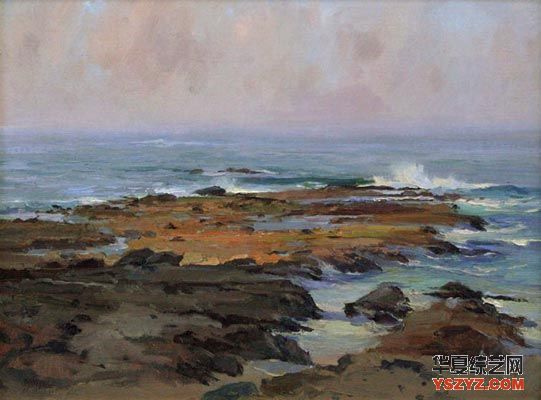
在这里我给最终关注边缘,软化一些像波浪飞溅,给建议的风和喷淋水。我评论其他领域来确定边缘质量和对比的价值,特别在焦点。我开发更多的定义进一步在大海的岩石,潮水退去,几波的迹象进一步了。阴影区域的前台完成后在右下角。最后一个阶段是远离画一段时间,看它用新鲜的眼睛第二天早上。观察这幅画在录音室远离源允许我去看这幅画,它是什么。在这一点上我应该所有的内脏反应从现场我需要。任何改进目前的设计决策,无论是简化或陈述更大胆地各个领域的绘画。和你去开始另一个。
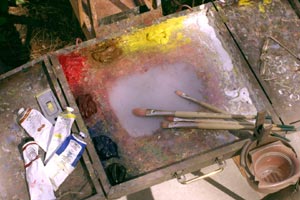
媒体:油/亚麻(克莱森斯油、单涂底漆没有。15)
调色板:温莎牛顿品牌油漆
钛白
镉柠檬
生黄土
永久玫瑰
永久暗红
深蓝色
象牙黑
原文如下:
Landscape Painting Demonstration in Oils – “Shaw Cove”
Stage 1
This painting was completed in July during the Sixth Annual Laguna Plein Air event in Laguna Beach, CA. I used a digital camera on-location to capture the painting during its various stages. I have various starts to my paintings. Depending upon the intricacy of the scene I may start with a more refined sketch or in this case I started with a loose oil paint/mineral spirits wash to define the masses. This beginning stage sets the pace as to the view point of the scene, the light and shadow masses and the positive and negative areas of the scene. The artist also needs to develop the focal point very soon or at least know where this will happen in the composition.
Stage 2
This second stage is very important; I have to develop the areas that are in shadow in relation to the areas that are in light. This area will be the secondary focal area of the painting. I already know where the main focal point will be, I just do not have time at this point to put it in. The plein air painter has to concern him or herself with the constant moving light. What is in shadow now may in ten minutes or less become filled with light so the artist needs to develop the painting with this in mind. Here I start to place paint in a more opaque fashion over the initial wash areas of light and shadow to establish the correct value and color temperature. The water area surrounding the rocks, are also given attention.
Stage 3
From the very beginning one of the things that caught my interest in this scene was the occasional wave action against the far rocks. This will be my main focal point, so in this stage I observe the waves for awhile to determine at what stage of the wave hitting the rocks, I want to portray. This is placed in along with developing the foundation of the ocean with the horizon line and placing in some of the sky value and color.
Stage 4
This is a refinement stage; my eyes continually scan the scene to see the harmony in the scene and to be sure of retaining that harmony in the painting. The sky is developed further with not value changes but subtle color temperature changes. More delicate attention to the subtle ocean colors with the suggestion of movement of waves. I also make understated additions to the rock area. Observing my tide chart I notice that the tide is going out so I will be aware of more rocks that will start to be exposed, this may be helpful in the finished composition.
Stage 5
This stage I continue to develop the subtleties of the ocean with additional light and dark values placed in certain areas to give the suggestion of waves and waves breaking on the rocks. I start to develop the shadowed foreground area in the lower left hand corner.
Stage 6
Here I give final attention to edges, softening some like the wave splash, giving the suggestion of wind and spray of the water. I review other areas to determine the edge quality and contrast of value, especial at the focal point. I develop more definition of rocks further out in the ocean as that tide recedes and a few indications of waves further out. The shadow area of the foreground is finished in the lower right hand corner. The very last stage is getting away from the painting for a while and looking at it with a fresh eye the next morning. Observing the painting in the studio away from the source allows me to see the painting for what it is. At this point I should have all the visceral response from the scene I need. Any refinements now are more design decisions, either simplifying or stating more boldly various areas of the painting. Sign it! and you’re off to start another.
Media: Oil/linen (Claessens oil, single primed no. 15)
Palette: Winsor Newton brand oil paint
Titanium White
Cadmium Lemon
Raw Sienna
Permanent Rose
Permanent Alizarin Crimson
Ultramarine Blue
Ivory Black



